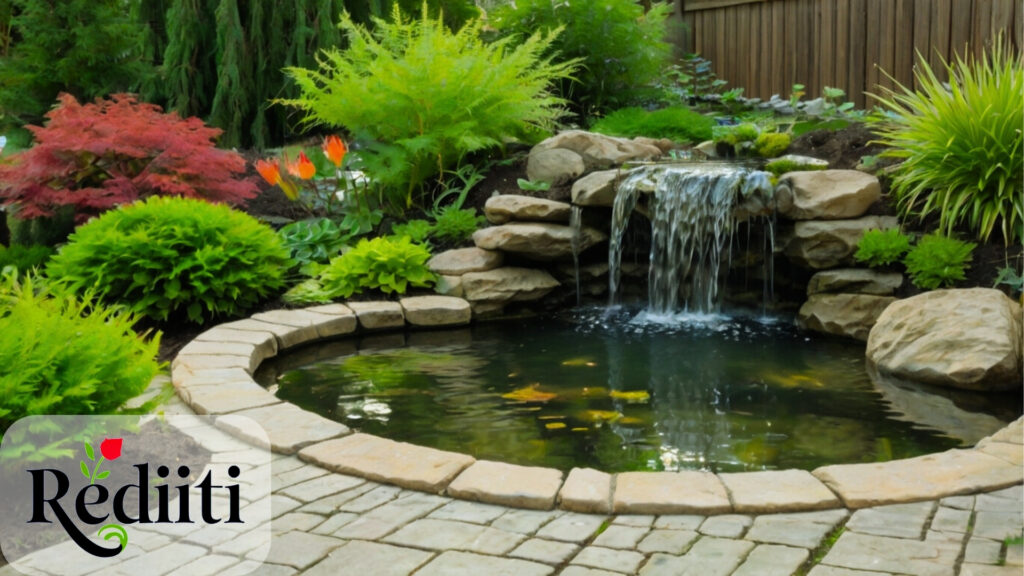Creating a small garden pond with a waterfall is a delightful addition to any backyard, providing a tranquil oasis that enhances the beauty of your outdoor space. In this comprehensive guide, we will walk you through the steps to build a stunning garden pond with a waterfall. This detailed tutorial covers everything from planning and design to installation and maintenance.
Table of Contents
TogglePlanning Your Garden Pond with Waterfall
Choosing the Right Location
Selecting the ideal location for your garden pond and waterfall is crucial. Consider the following factors:
- Sunlight: Ensure the spot receives at least 4-6 hours of sunlight daily to support aquatic plant life.
- Visibility: Choose a location where the pond will be visible from your home and outdoor seating areas.
- Drainage: Avoid areas prone to waterlogging, as this can affect the pond’s structural integrity.
Designing Your Pond and Waterfall
Designing your garden pond involves careful planning. Here are key elements to consider:
- Size and Shape: Determine the size and shape of your pond based on available space and personal preference.
- Depth: For fish and plants, a depth of at least 18-24 inches is recommended.
- Waterfall Placement: Plan the waterfall to ensure it enhances the visual appeal and promotes proper water circulation.
Gathering Materials and Tools
Before starting construction, gather all necessary materials and tools:
- Pond Liner: Choose a durable liner, such as EPDM rubber, to prevent leaks.
- Pump: A submersible pump with adequate capacity to circulate water from the pond to the waterfall.
- Filter: A biological or mechanical filter to keep the water clean.
- Rocks and Stones: Various sizes for the pond edges and waterfall construction.
- Aquatic Plants: To create a natural look and support the pond ecosystem.
- Shovel, Rake, and Wheelbarrow: Essential tools for digging and moving materials.
Constructing the Garden Pond

Marking and Excavating
- Outline the Pond: Use a garden hose or rope to mark the pond’s shape on the ground.
- Excavate the Area: Dig the pond area according to your planned depth, creating shelves for plants if desired.
- Remove Debris: Clear out rocks, roots, and sharp objects that could puncture the liner.
Installing the Pond Liner
- Position the Liner: Lay the liner in the excavated hole, ensuring it covers the entire area with some overlap at the edges.
- Smooth Out Wrinkles: Carefully smooth out any wrinkles and folds in the liner.
- Secure the Edges: Anchor the liner edges with rocks or soil to hold it in place.
Filling the Pond
- Add Water: Begin filling the pond with water, adjusting the liner as needed.
- Check for Leaks: Monitor the water level to ensure there are no leaks.
Building the Waterfall
Constructing the Waterfall Base
- Create a Foundation: Use rocks and stones to build a stable foundation for the waterfall.
- Position the Pump: Place the submersible pump at the bottom of the pond, connecting it to the waterfall area with tubing.
Building the Waterfall Structure
- Layer Rocks and Stones: Arrange rocks and stones to form the waterfall’s tiers, ensuring each layer directs water flow.
- Install Tubing: Conceal the tubing within the rocks, positioning the outlet at the top of the waterfall.
Testing the Waterfall
- Power the Pump: Turn on the pump to test the waterfall, adjusting the rocks as needed to achieve the desired flow.
- Check for Leaks: Ensure there are no leaks in the waterfall structure.
Adding Finishing Touches
Edging and Landscaping
- Edge the Pond: Use decorative rocks and stones to create a natural-looking edge around the pond.
- Landscape Around the Pond: Plant aquatic and marginal plants around the pond to enhance its natural appearance.
Introducing Aquatic Life
- Add Plants: Introduce aquatic plants such as water lilies, lotus, and marginal plants to create a balanced ecosystem.
- Stock with Fish: Once the pond is stable, add fish like koi or goldfish, ensuring they have adequate space and hiding spots.
Maintaining Your Garden Pond with Waterfall
Regular Maintenance Tasks
- Monitor Water Levels: Regularly check and maintain appropriate water levels.
- Clean the Filter: Clean the filter periodically to ensure efficient water circulation.
- Remove Debris: Skim leaves and debris from the pond surface to prevent clogging.
Seasonal Maintenance
- Spring: Perform a thorough cleaning, removing any accumulated debris from winter.
- Summer: Monitor algae growth and treat as necessary, ensuring plants and fish are healthy.
- Fall: Remove fallen leaves and prepare the pond for winter by trimming plants and adding a net if needed.
- Winter: If the pond is in a freezing climate, ensure the pump and equipment are protected from ice damage.
Troubleshooting Common Issues
Algae Overgrowth
- Solution: Introduce more aquatic plants to compete with algae for nutrients and consider using an algaecide if necessary.
Water Clarity Problems
- Solution: Check and clean the filter regularly, and ensure the pond is not overstocked with fish.
Pump Malfunction
- Solution: Inspect the pump for obstructions and clean it as needed, replacing worn-out parts promptly.
Building a small garden pond with a waterfall is a rewarding project that adds beauty and tranquility to your outdoor space. By following this detailed guide, you can create a stunning water feature that will provide years of enjoyment.





